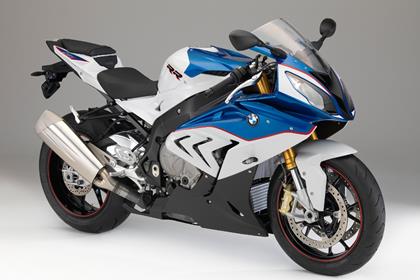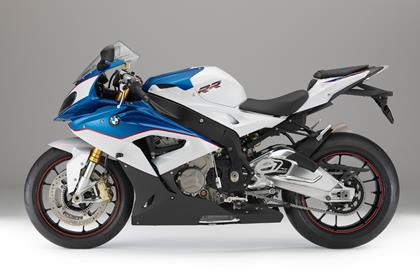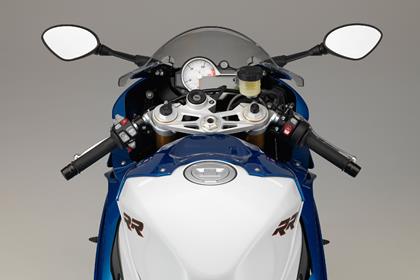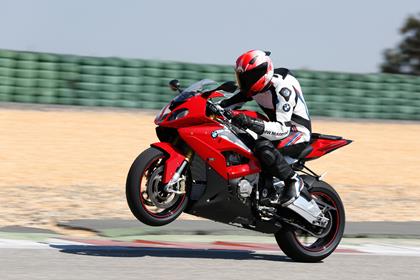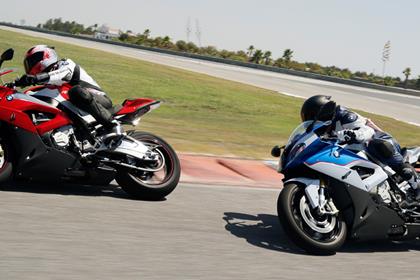Cologne Show: New BMW S1000RR
• 999cc, inline four-cylinder, water-cooled
• 199bhp / 83.3lbft
• New twin spar aluminium frame
• Semi-active suspension
• Restyled bodywork
BMW’s superbike rivals must be wondering just what they have to do to keep up as the German firm reveals a completely new, lighter, more powerful and even more advanced version of the S1000RR; a bike that already dominates the class.
The 2015 S1000RR is the first completely new version of the bike since the original appeared in 2009; the 2012 overhaul being merely a bit of a polish up in comparison and it has distilled five years of racing and road bike experience to bring these changes to the new bike.
Nobody ever stepped off an S1000RR yearning for more power or less weight; but now they have both in the form of 199bhp at a searing 13,500rpm and a belting 83.3lbft torque, while the weight has dropped (even with all of the electronics and ABS system fitted) from 209kg to 204kg fully wet.
At the heart of the claimed 199bhp are changes including a newly-engineered cylinderhead, a new intake camshaft and lighter intake valves.
The airbox has been changed for a larger capacity and shorter intake lengths, while the all-new exhaust system ditches the front underbelly silencer to contribute to a 3kg weight loss. A lighter battery sheds another kilo from the total, too.
The frame changes are also comprehensive. The twin-spar aluminium alloy frame is both stiffer and lighter and gets new geometry with new steering head angle, wheelbase and a new swingarm pivot point.
The new S1000RR can also be specified with an updated version of the semi-active BMW Dynamic Damping Control (DDC) suspension system.
In terms of the electronics, BMW have fitted three standard modes of Rain, Sport and Race. They can be supplemented by the Pro riding mode option to give a further two, track orientated modes of Slick and User. Pro riding mode also offers launch control and a programmable pitlane speed limiter.
There’s also include a quickshifter for faster gearchanges both up and down the ‘box. The traction control has been recalibrated to work with the ABS and uses lean angle sensors to further improve the safety systems.
The S1000RR even gets optional cruise control and heated grips, along with a new LCD dashboard.
New S1000RR electronics
The BMW S1000RR set the standard for the superbike class when it was launched in 2009, but the challenge from the Ducati 1199 Panigale and Aprilia RSV4 has been hard fought. BMW are aiming to take the top step again with the 2015 S1000RR, which gets a host of new electronic rider aids.
Standard fit electronics include the three riding modes of Rain, Sport and Race as well as Automatic Stability Control (ASC) with a lean angle sensor. Add the Pro riding mode as an option and you get Slick and User modes along with Dynamic Traction Control (DTC), which adds the banking sensor and seven stages of traction control intervention.
The different riding modes modify engine power and torque, traction control and suspension set-up and ensure the ABS system is matched in the best way for the conditions. The optional User mode means the rider can tailor all of the different electronic settings to their own tastes.
Engine
Significant reworking of the 999cc engine has resulted in a 6bhp boost at peak, thanks to new intake cams, lighter valves, a new airbox and an all-new exhaust system – which also sheds 3kg.
Styling
The asymmetrical face of the RR has been reversed for 2015, while the whole package has been lightened and sharpened.
Electronics
A raft of features have trickled down from the HP4, and the new bike gets semi-active suspension, second generation traction control and quickshifter, and new riding modes.
Chassis
The biggest change to the new frame completely revised back section, adding more flex around the swingarm pivot to improve drive, mechanical grip and feedback.
ORIGINAL STORY
BMW have confirmed that they will release three new models at tomorrow’s Intermot show in Cologne, Germany.
Amongst the three is expected to be an all-new S1000RR, boasting new chassis, new bodywork, heavily revised electronics and strong rumours the engine has undergone the same level of development.
Not only will the new bike represent a serious increase in performance over the current model, it will also eclipse the spec of the firm’s flagship HP4, which will cease to be a part of the model line-up in 2015.
More power, more control
The new RR has still not been seen completely without any disguise, but with several very clear spy shots to work with, MCN commissioned this digital rendering (red and white S1000RR) to show all the design elements of the new bike.
Tomorrow we’ll see how close we are to the real deal, but this is as close as we can get to a photograph of the finished bike.
What can’t be seen in the spy shots is the rumoured engine work, which our European factory source suggests has been significant.
The net result is expected to be a hike of ‘five or six’ bhp at peak compared to the out-going model, meaning that the new RR will boast an output nudging 200bhp in standard tune.
While the crankcases look to be near-identical between the existing bike and the test mules, it’s thought that all the development has gone into the cylinder heads to achieve the power boost, in conjunction with a complete new exhaust system.
Power is nothing without control though, and BMW is continuing to use the S1000RR to showcase its technological prowess.
With the HP4 being discontinued for 2015, the RR is expected to benefit from everything that model had to offer, including the ‘cornering ABS’ which became available on the HP4 just a few months ago.
The system, developed by Bosch and also used by KTM on the 1190 Adventure, enables the rider to brake heavily mid-corner without tucking the front, or causing the bike to stand up.
This system will be linked to the RR’s rider modes and the HP4’s semi-active suspension (dynamic suspension system DDC), which is also expected to become standard fitment.
With chassis mods aimed at delivering more flex around the swingarm pivot for greater feel and connection between the back tyre and the tarmac, and the increased control offered by the suspension and electronic improvements, the RR is certain to widen the existing gulf from its competitors.
Expected changes
Chassis
The RR appears to have a new frame, and the clearest indication is around the rear section. The expectation is that more flex has been dialled in to increase connection
and drive.
Front cowl
The biggest change to the styling of the new RR can be found in its face. BMW appears to have reversed the asymmetrical headlamps compared to the 2010-14 models, while also adding a beak at the base of the cowl, which we have also seen in spy shots of the sport-touring version of the S1000, which we believe will
Electronics
What is impossible to identify from the spy shots is the level of electronic development on the RR., but we’d expect all the HP4’s functionality, and second generation traction control.
Exhaust
One of the first new details that emerged from the spy shots was a new exhaust system. The first image showed an aftermarket Akrapovic version with twin exits, while the most recent shot shows the new exhaust to be a more conventional unit, but more trapezoidal in shape.
Rearsets
The first two spy shots show the 2015 bike has new rearsets to go with the new main chassis. BMW’s Gear Shift Assistant (quickshifter) is visible in the shots, and we know the firm has been working on a new version – likely to be fitted to their flagship sportsbike.
Fairings
The spy shots show completely new bodywork on both sides, while maintaining the bike’s trademark asymmetry. BMW is clearly keen for this new model to look like an evolution, not revolution, building on the existing bike’s popularity, but maybe missing the chance to appeal to a new pool of buyers.
Brakes & Suspension
The 2015 bike is expected to get the new version of Bosch’s cornering ABS, which was made available on the HP4 earlier this year.
Dubbed ABS Pro by BMW, it will be standard fit on the new RR, and will communicate with semi-active electronic suspension, and multiple rider modes, including a new rider-set mode.
